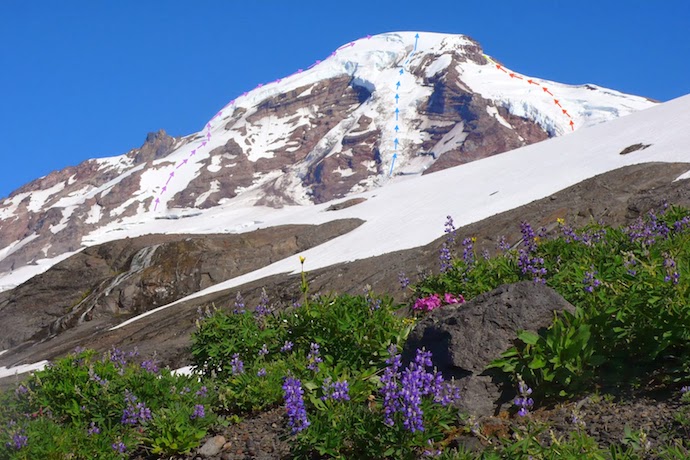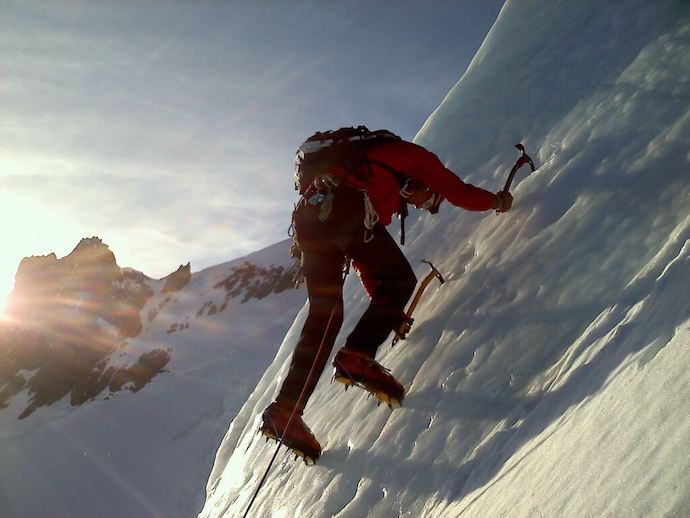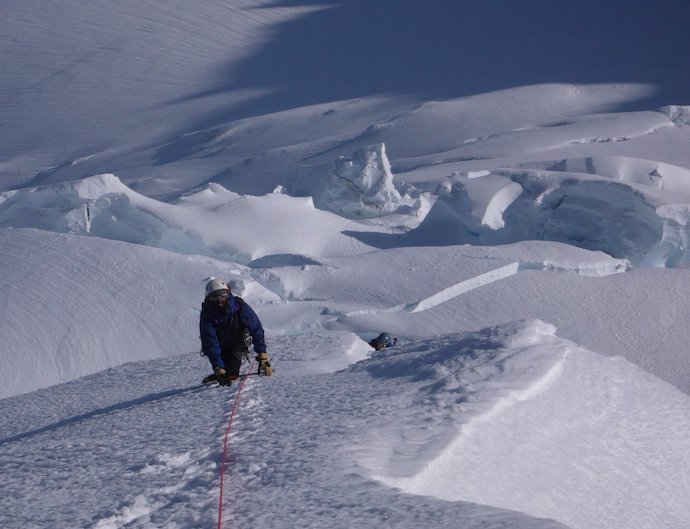Mt. Baker, North Ridge
Route Profile
Location: North Cascades of Washington, Mt. Baker Wilderness
Season: Nearly year round. May through September bring the best snow and ice conditions on the route. The approach gets significantly more involved as the season wears on.
Time required: 1-3 days.
Approach: 2.6 miles on good trails to the beginning of roped glacier travel; 2.5+ miles across Coleman/Roosevelt Glaciers to base of ridge, with greater distance in late season.
Difficulty: AI 2+, II–III+, depending on glacier condtions.
Map: Green Trails 13SX, Mt. Baker Wilderness Climbing Map
Route Summary: From the Coleman Glacier flats on the west side of to the lower North Ridge, a 50-degree snow slope leads to the ridge crest. Climb the slope for 800 feet and until on the crest. In early season, an alternate start begins from the Roosevelt Glacier at the very base of the ridge, but this start may be blocked by bergschrunds later in the season. Follow the crest to the base of a prominent ice cliff. From here climb 2–4 pitches of technical alpine ice ranging from 60–85 degrees depending on line choice and conditions. Above the technical ice, wind along the broad crest weaving through glacier features as needed until you reach the summit plateau.
Notes: This route is among the most aesthetic alpine ice routes in the North Cascades, and is one of "The AAI Fifty", our list of 50 classic climbs. Its long season, exposed position, and quality ice pitches put it in a very select class of alpine routes.

Mt. Baker's north aspect in the summer. From left to right, the North Ridge (purple); the Coleman Headwall (blue) and the Roman Mustache (red). An alternate start for the North Ridge ascends to the left of the rock rib. Andrew Yasso.
Route Details
The North Ridge, like many popular Cascades routes, is usually climbed between the start of May and the end of August, but it can be done almost year-round. In early season, you have to contend with deep, soft snow from the previous winter, and in late season you have to carefully navigate through the maze of crevasses on the Coleman Glacier.
From Helioptrope Ridge Trailhead, hike the trail until approximately 5400'. From here, you can either branch off and head east towards Harrison Camp (aka Mirkwood), although most climbers continue up the trail to higher camps either on the bare rock at the edge of the Coleman Glacier, or up on flat areas of the Glacier at approximately 6800' - 7000'. To start the climb you drop down and traverse through the Coleman, weaving through the crevasses along a ramp at about 6600'. Once you've made it across the glacier, climbers have two options: throughout the majority of the season, you can climb through the hourglass (shown in the photo above), or in later season when the hourglass is melted out, you may have to circle around further to the left before starting up the ridge proper. The later option adds more time to the climb, but avoids serious rock-fall potential.
Climb the lower half of the Ridge until 8800', where you will transition from glacier travel mode into roped climbing mode. Climbers will head out and around to the left (East) of the starting ice bulge for 1-1/2 to 2 pitches, then topping out at a broader, more northerly facing and lower-angled slope. This broad slope can vary in difficulty, ranging from deep snow wallowing in early season to firm neve-kicking later on. Progress up these shallower slopes for 2-3 pitches as you are funneled towards the lobe of the upper ice cap. At 9600', there is another step of 60 - 70 degree ice for 2 pitches.

AAI guide Tad McCrea starts the first pitch of alpine ice at about 8800' on Mt. Baker's North Ridge. Jeremy Wilson.
After topping out on the shoulder of the ice cap, trend to the left (east), winding through crevasses, to reach the summit proper.
For the descent, head west across the broad summit plateau and descend the Roman Wall to the saddle between the Demming and Coleman Glaciers at 9000'. From the saddle, descend to the north and traverse below the Black Buttes and return to camp at Heliotrope Ridge.
AAI climbs this route regularly as part of our Alpine Ice Course. This 6-day course reviews basic glacier travel and crevasse rescue skills before diving into more complex crampon and ice axe techniques. We will teach you the skills necessary for difficult alpine ice climbs, including ice screw placement, anchor building, hazard evaluation, glacier travel and navigation, and more. We have these courses scheduled every week from May through August. Please email us or call for more information on climbing this amazing route!
Guide Coley Gentzel's North Ridge Story
by Coley Gentzel
Former AAI Program Coordinator and Guide
I have been alpine climbing for a little over 10 years. Over that span, I have been fortunate with weather and conditions more often than not and can recall having failed on alpine climbs only a handful of times. In nearly every case, there has been something unique about these failures. More often than not, when I have failed once on a route, it has taken me at least a couple more efforts to finally succeed on it. In many cases these routes have become my nemeses.
Mount Baker’s North Ridge was one such route. I made three attempts with various partners over a two-year period before finally succeeding on the route on my 4th attempt. On my first attempt, we chose an approach route that led us into a maze of bottomless crevasses in the middle of the night. After probing particularly close to the lip of one gaping monster and causing a small ice avalanche, we decided to forgo the effort and climb the standard route.
My second try was in the face of a less than favorable forecast. Being the youthful and eternally optimistic alpinists that we were, we pushed up to a high camp on the Coleman glacier anyhow. The 13 hours I spent fully clothed, boots and all, in my leaky bivy sack that night were among the most miserable of my life. At one point I actually took to counting the drips on my face while lying in my puddle sack. Not nearly as comforting as sheep, but it almost worked as I came close to drifting off to sleep at one point. It wouldn’t have been quite so bad if we hadn’t been absolutely terrified of the lightning that was shredding the sky all around us. At least all of our metal was in a pile a few yards from our bivy sacks.
My third try came later than summer. Another AAI employee and I took a mid-week day off from work to give the route a go in classic Cascades car-to-car style. After a brisk hike from the trailhead that we started at about midnight, we were approaching the edge of the glacier in good time. But my partner got a case of the hot heels and we headed down only hours into the mission. I was at work on time in Bellingham, with a sour attitude to go along with the disappointment.
The next spring, fellow guide Andy Bourne and I decided to finish this thing off for once and all. We climbed the route in 12 hours car-to-car, and the climb couldn’t have gone more smoothly. Well ... that is not entirely true. I forgot my sunglasses and had to poke holes in the back of my balaclava that I used for a face mask. During a brief stop on the decent, Andy fell asleep with half of a Cliff bar still in his mouth and nearly had to be revived. Quite a pair.

AAI guide Viren Perumal just above the end of the technical ice pitches. Coley Gentzel.
It was nearly five years until I returned to the North Ridge. I went back with a friend this winter and despite the perfect forecast, we ran into 70mph winds and single digits temps on the glacier. We huddled in a snow cave for a few hours hoping that the thousand foot plume of snow and ice ripping off the summit would subside. Uncontrollable shivering forced us out of the cave and back to our car. North Ridge = 4; Coley = 1.
Though they have been hard to swallow and rough on my pride, I have learned as much if not more from these failures than I have from many flawless outings on other peaks and routes. Remember that failing is part of trying and if you are doing one, you probably aren’t doing the other!
How to Climb the North Ridge with AAI
The best way to do this climb is to take our 6-day Alpine Ice Climbing course. This course, the first AAI ever offered in 1975, is an intensive introduction for aspiring leaders, and covers everything from traditional single axe ice climbing positions through leading on steep seracs with modern ice screws and tools. The course culminates with an ascent of the North Ridge or Roman Mustache, depending on conditions.
If you are already familiar with basic ice climbing and have practiced crevasse rescue, you can set up a private climb through our office. See our Guided Climbing in the Cascades page for more information.
Program Finder